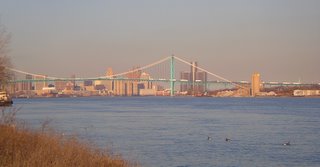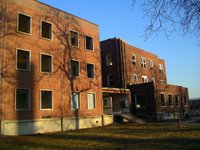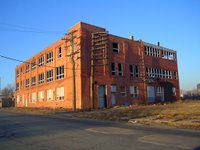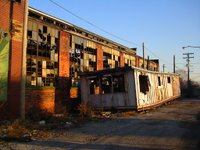 With a week to go until the Big Day, the River Rant Committee on Major Event Preparation is proud to report that, by and large, the City of Detroit is looking better than it has in 30 years and is ready for the arrival of tens of thousands of football fans, the international press, and world-wide scrutiny. But only if your definition of Detroit is the limited to the downtown Central Business District ("CBD"). As soon you head one mile north, south, or west, it's as bad as ever.
With a week to go until the Big Day, the River Rant Committee on Major Event Preparation is proud to report that, by and large, the City of Detroit is looking better than it has in 30 years and is ready for the arrival of tens of thousands of football fans, the international press, and world-wide scrutiny. But only if your definition of Detroit is the limited to the downtown Central Business District ("CBD"). As soon you head one mile north, south, or west, it's as bad as ever. The Good
The Good
Never before have we seen the CBD looking so clean and fresh, with new businesses and restraurants and public facilities. The streets have been cleaned to where you could eat maple-walnut ice cream off the asphalt. The regular downtown derelicts who pester every pedestrian for a cigarette and a dollar have been rounded up and moved elsewhere (or displaced by the SB contruction projects). Long empty storefronts on Woodward Avenue have been boarded up and painted, or- even better, temporarily re-opened as Super Bowl XL apparel shops. We have to give credit where credit is due, although making such deter-mination isn't crystal clear. Current Mayor Kwame Kilpatrick would like to take sole responsiblity for every improvement in the city (of course), but the fact is former Mayor Dennis Archer and several local philantropists (like Roger Penske and Mike Illitch) deserve equal, if not more credit. And a great deal of respect goes to companies like Compuserve, who invested millions into building their corporate headquarters in Detroit (pictured here on a rare clear Michigan winter day). Despite the improvements, this fact remains: investing entreprenurial capital in the city remains a risky and couragous endeavor. The endlessly-persistent obstacles of high taxes, an obscene crime rate, corrupt local politics, and inefficient municipal services make rebuilding this once-prized American city as daunting as setting up shop in Fallujah or Mosul.
We have to give credit where credit is due, although making such deter-mination isn't crystal clear. Current Mayor Kwame Kilpatrick would like to take sole responsiblity for every improvement in the city (of course), but the fact is former Mayor Dennis Archer and several local philantropists (like Roger Penske and Mike Illitch) deserve equal, if not more credit. And a great deal of respect goes to companies like Compuserve, who invested millions into building their corporate headquarters in Detroit (pictured here on a rare clear Michigan winter day). Despite the improvements, this fact remains: investing entreprenurial capital in the city remains a risky and couragous endeavor. The endlessly-persistent obstacles of high taxes, an obscene crime rate, corrupt local politics, and inefficient municipal services make rebuilding this once-prized American city as daunting as setting up shop in Fallujah or Mosul. On Superbowl weekend 2006, as U.S. troops in Rumalah and Kabul and other bloody God-forsaken locales around the world watch the Big Game, Detroit will embody all that makes us American. As crews raised warming-tents and adorned the trees with Christmas lights, we witnessed sparks of kinetic energy and a spirit of renewal long absent in this challenged city. For a tranquil minute, as families skated in the January sun at Campus Martius and snow-machines blew fake snow for a sledding hill, as the waning half-light cast a warm orange glow on the skyscrapers, it felt like we were standing in one of America's most regal of cities...
On Superbowl weekend 2006, as U.S. troops in Rumalah and Kabul and other bloody God-forsaken locales around the world watch the Big Game, Detroit will embody all that makes us American. As crews raised warming-tents and adorned the trees with Christmas lights, we witnessed sparks of kinetic energy and a spirit of renewal long absent in this challenged city. For a tranquil minute, as families skated in the January sun at Campus Martius and snow-machines blew fake snow for a sledding hill, as the waning half-light cast a warm orange glow on the skyscrapers, it felt like we were standing in one of America's most regal of cities...
The Bad
Then reality abruptly reared it's ugly head and shattered the bucolic moment, right in front of us and impossible to ignore (be patient, it takes a couple of minutes to download. Not like you're doing anything important right now. Hell, if you read RR, you obviously have more time than you know what to do with). He was a food service employee at the nearby Au Bon Pain coffee shop. She was an ex-girlfriend or wife or who knows. Security guards hustled her off the premises, and his boss came outside and yelled at him to "keep that shit away from here." An ephinany followed; the CBD ain't the real D. So we left and went searching for the grimy town we've known for the last three decades. And the Ugly
And the Ugly
It took all of five minutes before we found true Detroit. Despite the downtown improvements, despite the new ballparks, despite the new cultural features, the city remains one of the most destitute, most crime ridden, most impoverished places in the developed world. Nowhere else (but Baghdad, perhaps) will you find more than 10,000 abandoned homes and businesses. The level of blight is impossible to describe. In neighborhoods like Del Ray and St. Aubin, it's not unusual to see entire city blocks where every home has been abandoned and all that remain are burned-out shells. The only inhabitants left are the addicts and the predators, the hustlers and the truly downtrodden. In some areas, it's as if the buildings have been stricken with some rare degenerative disease, the kind that causes a structure to implode on itself. This is a most unique Detroit phenomenon; why do so many buildings made of brick and steel collapse on their own volition? Vandalism can not bear total responsibility. And how does a canopy made of canvas outlast brick walls and a steel girder roof? So many questions in the D are not easily answerable.
In some areas, it's as if the buildings have been stricken with some rare degenerative disease, the kind that causes a structure to implode on itself. This is a most unique Detroit phenomenon; why do so many buildings made of brick and steel collapse on their own volition? Vandalism can not bear total responsibility. And how does a canopy made of canvas outlast brick walls and a steel girder roof? So many questions in the D are not easily answerable. The old banks, with their thick walls of reinforced cement, are the only structures resistant to this plague. The roofs may collapse (through the windows at this branch you can see tree saplings fifteen feet tall shimmering in the slot-roof shards of sunlight), but the four sides will still be standing come Armageddon day. This must have been apparent to local clergymen as well, for when the banks closed they often became churches. Handpainted signs such as "The New Detroit Apostolic Temple of Holiness" or "The Greater Mt. Zion House of Praise" are posted underneath the old mason-cut "National Bank of Detroit" inlays. But in the end, even God's chosen ones recognized this was not the promised land of Canaan and departed.
The old banks, with their thick walls of reinforced cement, are the only structures resistant to this plague. The roofs may collapse (through the windows at this branch you can see tree saplings fifteen feet tall shimmering in the slot-roof shards of sunlight), but the four sides will still be standing come Armageddon day. This must have been apparent to local clergymen as well, for when the banks closed they often became churches. Handpainted signs such as "The New Detroit Apostolic Temple of Holiness" or "The Greater Mt. Zion House of Praise" are posted underneath the old mason-cut "National Bank of Detroit" inlays. But in the end, even God's chosen ones recognized this was not the promised land of Canaan and departed. In the last forty years, nearly 1,000,000 residents have left the city. It's not just the neighborhoods that remain abandoned and forlorn. Numerous former auto-manufacturing businesses, once an intregral part of Detroit's golden age of industrial superiority, sit vacant. The future does not bode well. In the last week, Ford Motor Company announced a lay-off of 30,000 employees (nearly 1/3 of their workforce). Analysts are predicting a similiar down-sizing at General Motors. The only new automotive development in the state is a Toyota design facility, to be built an hour away from Detroit in pastoral Saline.
In the last forty years, nearly 1,000,000 residents have left the city. It's not just the neighborhoods that remain abandoned and forlorn. Numerous former auto-manufacturing businesses, once an intregral part of Detroit's golden age of industrial superiority, sit vacant. The future does not bode well. In the last week, Ford Motor Company announced a lay-off of 30,000 employees (nearly 1/3 of their workforce). Analysts are predicting a similiar down-sizing at General Motors. The only new automotive development in the state is a Toyota design facility, to be built an hour away from Detroit in pastoral Saline. Even the temporary buildings, brought in (we suspect) to facilitate the excavation of copper piping and scrap iron and whatever else of value, are left to the visagoths in the rush to leave the city. The vultures don't even give a shit. Sociologist James Q. Wilson refers to this breakdown of social mores as the "broken windows" theory; when delapidation and vandalism isn't stopped at the onset in distressed communities, it spreads like an agressive and malignant cancer.
Even the temporary buildings, brought in (we suspect) to facilitate the excavation of copper piping and scrap iron and whatever else of value, are left to the visagoths in the rush to leave the city. The vultures don't even give a shit. Sociologist James Q. Wilson refers to this breakdown of social mores as the "broken windows" theory; when delapidation and vandalism isn't stopped at the onset in distressed communities, it spreads like an agressive and malignant cancer. We hope SB XL goes off without a hitch. We hope the tens of thousands of people who come from around the world have a great time and enjoy themselves. We hope the millions of dollars generated from the event provides a much needed (albeit temporary) shot in the arm to the local economy. But we know, that come February 6, after everyone leaves and the Hollywood glitterati disappears, the D will still be the D, and except for the CBD, little will have changed.
We hope SB XL goes off without a hitch. We hope the tens of thousands of people who come from around the world have a great time and enjoy themselves. We hope the millions of dollars generated from the event provides a much needed (albeit temporary) shot in the arm to the local economy. But we know, that come February 6, after everyone leaves and the Hollywood glitterati disappears, the D will still be the D, and except for the CBD, little will have changed.
skip to main |
skip to sidebar
Pithy Banter and Less Than Inspired Photography

